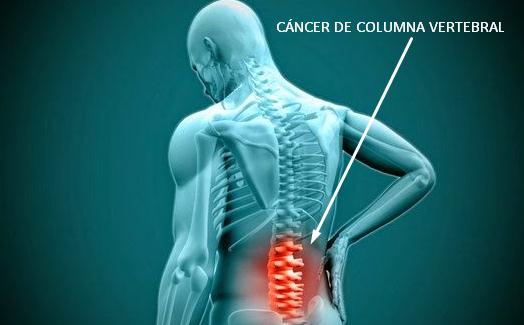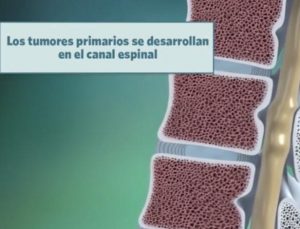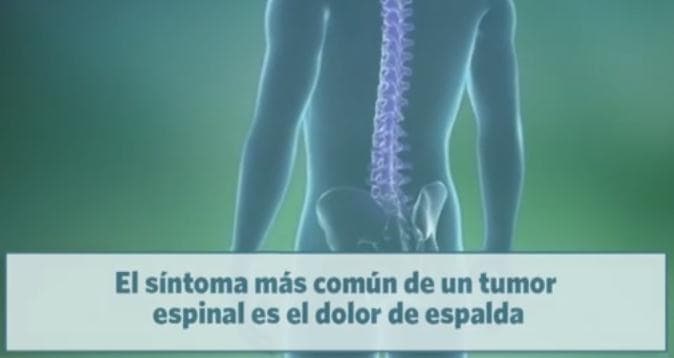The cáspinal cancer, is aggressively abnormal cell growth in the spine or vertebrae. It can develop in the bones, nerves and other tissues. Vertebral tumors represent around the 90% of the cáspinal cords.

The biggestía of spinal tumors are metastaticásick, that is, they originate in other parts of the body. They usually spread to the spine from the cábreast and lung cancersón in women or from the cáncer de próstate in men.
The cáSpinal cancer affects some 10.000 people toñO. Some tumors of the spine, like astrocytomas, They occur more frequently inñchildren and teenagers. Hereí we will show you their types, síntomas, causes and treatmentsáfrequent s.
Index
types of cáspinal cancer
There are many types of spinal tumors, that are diagnosed and treated by their locationón and c typeélulas that contain. lot cáSpinal cancers are divided into two types: primary and secondary.
 The “primary” develops within the spine. The tumors of the méspinal cord tooéthey can't be cáprimary or secondary nceres (evaluatedásick). The biggestía of primary and metastatic spinal tumorsásic are epidural tumors.
The “primary” develops within the spine. The tumors of the méspinal cord tooéthey can't be cáprimary or secondary nceres (evaluatedásick). The biggestía of primary and metastatic spinal tumorsásic are epidural tumors.
These tumors grow in the bones of the spine. As they grow, can compress the méspinal game, yesínerve breaks and spinal fluid. No isá clear thaté causes tumors to develop in the méspinal cord or meninges covering it.
Cancerous Spinal Tumors (in the vévertebrae) his Cáncered “secondary” o cáncer metastasesásico that have spread to the vévertebrae from another part of the body, like the moms, the prówait a he riñón.
There are other kinds of cáspinal cords, what are the so-called intradural tumors, which are divided into:
Intramedulares. These grow within the méspinal game, such as ependymomas and astrocytomas.
Extramedullary. They are the ones that grow out of the méspinal game, like meningiomas, schwannomas y ependimomas mixopapilares.
Sísymptoms of cáspine cancer
The sísymptoms of cáspinal cancer depend on the type of tumor, tamañO, locationón, patient health history, among others. The sísymptoms may occur gradually or rápiously. metastatic tumorsáPhysics often progress rápiously.

As a tumor grows in the spine, it can replace bones or compress nerves, causing compression fracturesón. Often the first síntoma of cáspinal cancer is the pain how do you feel about these changes.
The time of díat which the pain occurs can provide informationón important about the tumor. Pain that is experienced at night or in the morningñana and which improves as it moves is often a señto which the cáncer has suffered metástasis.
If the tumor presses on the méspinal game, there may be tingling or numbness in the arms or legs. The sísymptoms that develop afterés of a time include clumsiness, such as not knowing dónde isáno feet.
As the disease progresses, the sísymptoms of cáSpinal cancer may include weakness, inability to move your legs and, Finally, parálysis. The cáSpinal cancer can affect your ability to carry messages between the body and the brain.
The síntomas mácommon s of cáspinal cancer are:
- Back pain, neck and limbs
- Difficulty walking or standing
- Numbness and péloss of feeling in legs and arms
- Incontinence
- Deformationóno of the spine
- loss of sensationón
- muscle weakness and torqueálysis
- Paresthesia and skin húmeda
Causes of cáspinal cancer
The causes of cáspinal cancer is notánot very clear. It is thought that it can be generated by the existence of defective genes, that can be inherited or appear over time.
Environmental factors, lifestyle like: to foodón, smoking and stressés. Además of the exhibitionón to certain elements thatímonkeys, may be determining elements for the appearanceón de is type of cáncer.
Treatment for cácancer in the spine
Before starting somethingúno treatment, The specialists must carry out evaluations that allow to give security of the presence of the cáncer of columna. Often their sísymptoms resemble those of other diseases.
for the diagnosisóstico of the disease, different procedures are used, within which we have: neurol testsócool, imámagn resonance genesética, electroencephalogram, Scanneríto computerized and monitoring.
the surgeryíin these cases it is taken as a solutionóno last resort. Radiation therapy may be usedóno chemotherapy. Along with this for inflammationóthe use of corticosteroids is not recommended.
the oncósoon to beá the person in charge of treating the disease. after diagnosisóit is recommended to start therapy immediately. How fast you have to fight the disease, is many times
determinant in the complete recoveryópatient no..

Another minimally invasive treatment is radiosurgery.ía. It is méeveryone uses robotic radiotherapy to eliminate las cécancer cells in healthy tissue. The CyberKnife is an excellent choice.ón for patients with diff tumorsíeasy and patient where others have failedás tétechniques.
Some side effects caused by the different treatments are: reactions toéallergic to certain medications, náwear and fatigue, infections in the case of invasive treatments and complications during surgeriesías.
